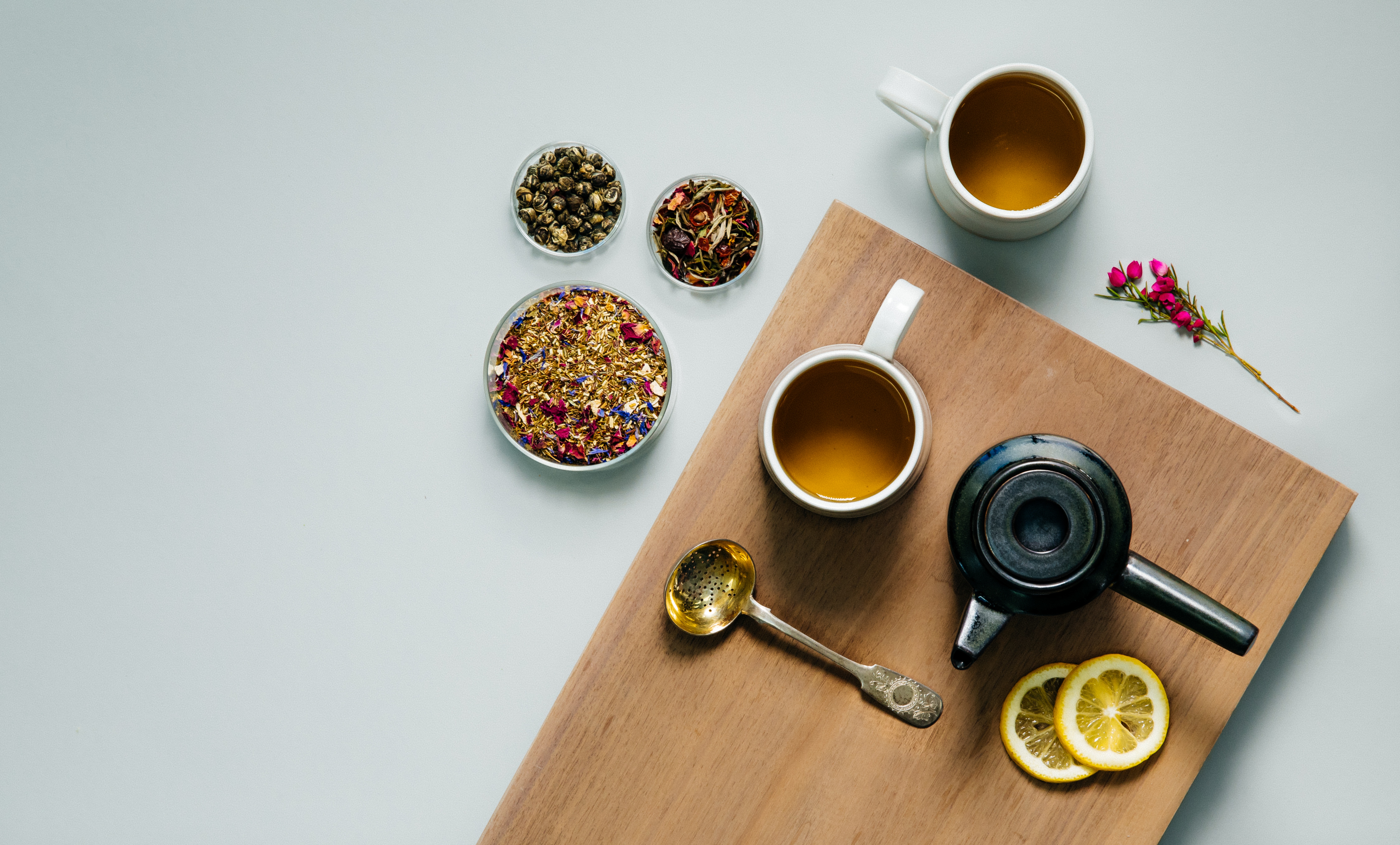Almost a billion people drink coffee or tea every day. For generations, these two beverages have been the centerpiece for societies and cultures and continued to be used by many for their health benefits. In fact, chances are you are indulging in one of these two drinks RIGHT NOW as you’re reading this article!
But that begs the question:
Which is better: tea or coffee?
While the debate will continue to rage on, we at Art of Tea decided to put together the ultimate guide on the differences between tea and coffee, their unique profiles, their popularity, their health benefits, and when to drink one instead of the other. (And even though we’re a tea company — trust us — a lot of people at Art of Tea enjoy a fresh cup of coffee too!)
So sit back, relax, grab your favorite drink, and read on to explore the wonderful worlds of coffee and tea that have been enjoyed for centuries.
Tea vs. Coffee: What Is It?
Tea = Leaves.
Coffee = Beans.
Right?
What is Tea?
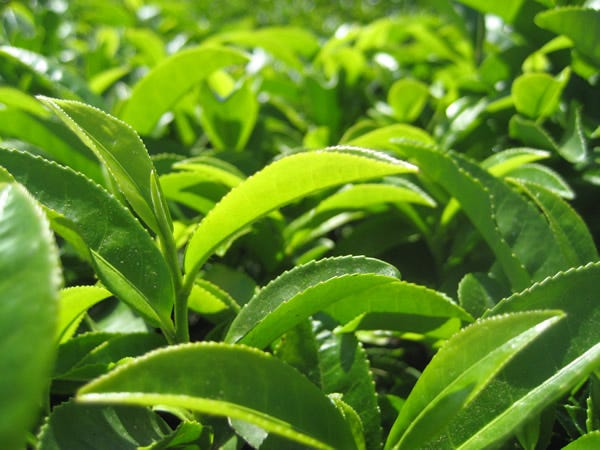
All tea actually comes from one single plant: The Camellia Sinensis plant. And technically, anything NOT from the Camellia Sinensis plant is a “tisane” or “herbal infusion” — like Egyptian Chamomile, Mint, and Rooibos.
Legend has it that a leaf of this plant randomly fell into the cup of the Chinese Emperor, and until the 1800’s, China actually cultivated and produced almost all of the world’s tea. Today, however, tea is grown in almost 40 different countries with most coming from China, Kenya, Sri Lanka, India, and Turkey.
And although there are thousands of different varieties of tea, they are usually separated into four categories: White, Green, Oolong and Black.
What determines the type of tea is oxidation (which we will explain later) — the same process that makes the inside of an apple turn brown after a few minutes. In general, the more oxidized the tea is, the darker it will be; white tea and green teas are the least oxidized while black tea has full oxidation of the leaves.
What is Coffee?
Coffee comes from the Coffea plant and the beans that we brew and drink actually come from the seeds of the plant’s fruit, called a coffee cherry.
All commercially grown coffee comes a part of the globed called the “Coffee Belt,” where the soil is rich, temperatures are mild, and there’s a lot of rain and sun.
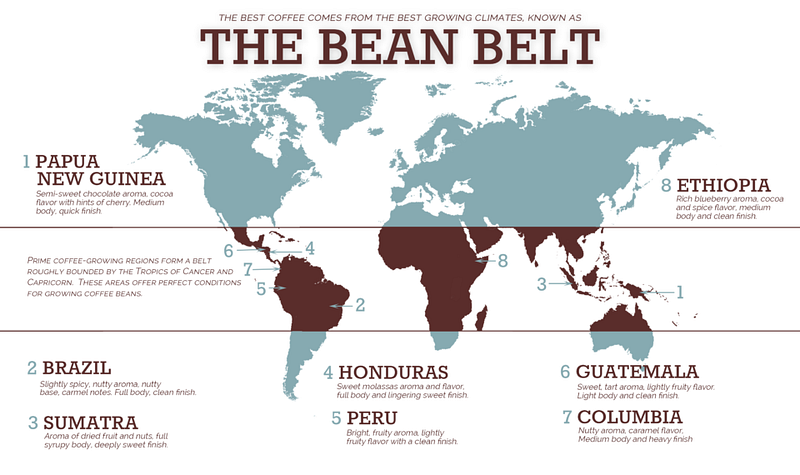
(Courtesy: The Ohio State University)
For coffee, the two most important species are Arabica and Robusta.
Coffee Arabica represents roughly 70% of the entire world’s commercial coffee. This type of tree generates flatter and longer beans than Robusta, a mild and fragrant coffee, and a lower caffeine content. Higher quality Arabicas are also grown at altitude — often between 2,000–6,000 feet above sea level.
Robusta represents about 30% of the world’s coffee production and comes almost entirely from parts of Southeast Asia, Central and Western Africa, and Brazil. These beans are smaller than an Arabica bean, have more caffeine, and are often used in blends and instant coffees.
Tea vs. Coffee: How It’s Made
So how does tea or coffee actually get to your cup? Where does it come from? How long does it take?
While both processes are pretty lengthy, we’ll give you the crib notes so you can get all the fascinating info before you grab another cup of coffee or tea!
Coffee: How It’s Made
The next time your sip your coffee in the morning, consider the lengthy journey each bean takes to grace your cup.
Step One: Harvest the Cherries
There are two ways to harvest coffee:
- Strip Picked: All cherries are taken off the branch at one time by machine or hand.
- Selectively Picked: Pickers only choose the ripe cherries by hand.
Step Two: Process the Cherries
There are two ways to process the cherries:
- Dry Method: The fresh cherries are dried in the sun, turned throughout the day, and covered at night or during rain. This process can last for weeks until the moisture content of the cherries drops to 11%.
- Wet Method: The fresh cherries have their skin and pulp removed from the bean via a pulping machine.
After the beans are separated by weight and size, the beans are sent to fermentation tanks full of water. Here, they stay in these tanks until the slick layer that surrounds the bean — called the parenchyma — breaks down.
Step Three: Milling the Beans
If the coffee is wet, machines remove the parchment layer from the bean. If the coffee is dry, machines remove the entire husk of the cherries.
During this step, beans are also sorted, graded, and reviewed — any unsatisfactory beans are removed by hand and/or machinery.
Step Four: Tasting the Coffee
Once the coffee is exported, it gets analyzed for quality and taste in a process called “cupping” — an expert cupper has a palate than can taste the tiniest differences in flavor between the numerous samples each day. This step is where they create the unique roasts and blends we enjoy every morning.
Step Five: Roasting the Coffee
Roasting machines cycle beans at a temperature of over 500 degrees. When the inside of a bean reaches about 400 degrees, it turns brown and releases its fragrant oil — this is what produces the delicious taste and smell of the coffee we love.
Step Six: Grinding Coffee
Then, the roasted coffee beans are ground to deliver the most flavor possible into your drink.
Tea: How It’s Made
As you watch the tea leaves dance in water, think about the incredible steps each leaf takes to unleash its full flavor and aroma.
Step One: Plucking
The leaves are harvested by hand with pickers grabbing the unopened bud to the top three leaves and the bud, depending on the tea. After plucking, the leaves are sorted and unsatisfactory parts get removed.
Step Two: Withering
After picking, the leaves are laid out to dry to prepare them for further processing and get gently rotated to ensure even exposure to the air. Tea leaves can be stiff and, without this step, they can shatter and crumble when rolled and shaped. This also process reduces the water content in the leaves.
Green teas, however, are steamed, pan-fired, or baked without withering (or with a very brief withering process) to stop oxidation of the leaves so they stay green.
Step Three: Rolling
These softer tea leaves are pressed, rolled, or twisted to break down the cell walls of the leaves, releasing its juices and oils, exposing its enzymes and oils to the oxygen to start oxidation, and contributing to its unique flavor notes.
Step Four: Oxidation
After rolling, the leaves are laid out to rest to allow oxidation to take place.
Here, the oxygen in the air blends with the leaf’s enzymes, which changes the chemical composition and adds a reddish-brown color. This works to unleash the complex and tasty flavor notes in your beverage. The length of oxidation, however, depends on the tea and the environment.
Step Five: Drying or Firing
During this last step, the tea is dried evenly — without being burned — in large ovens or drying machines to lock in the flavor and stop the oxidation. This also ensures the tea will keep well.
Step Six: Art of Tea Process
Once the fresh tea arrives at Art of Tea from the top botanicals in the world, we store all our leaves in the “blending room” — a sacred room that keeps every single leaf under 78 degrees Fahrenheit with the perfect humidity level (because too much humidity hurts tea) and respects that each tea comes from mist, clouds, sun, and earth.
Then, we hand blend almost all of our teas so we protect the leaf and its flavor.
It’s like making a mouth-watering, delicious meal: Everything is fresh to order — everything is blended fresh, made fresh, and delivered fresh.
Check out what goes on behind the scenes at Art of Tea:
Finally, we give every product at Art of Tea a lot number — that way, we can trace each tea, each leaf, each berry, and each ingredient so we can check everything. If there’s ever any discrepancy or issues with flavor, we can look up each ingredient from the source.
Tea vs. Coffee: Which Is More Popular?
Short answer: Tea.
Tea is the most-consumed beverage in the world after water.
BUT, the choice between coffee or tea depends on where you are and how old you are, too. In the United States, for example, 54% of American adults drink coffee every day, with an average of about 3 cups per day.
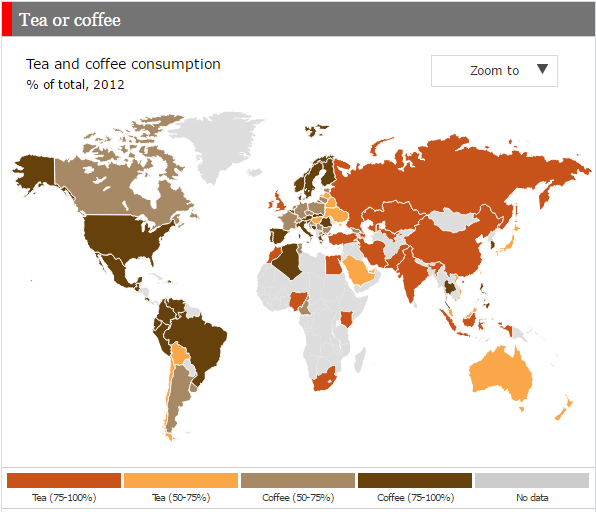
(Courtesy: The Economist)
Here are the breakdowns of several countries:
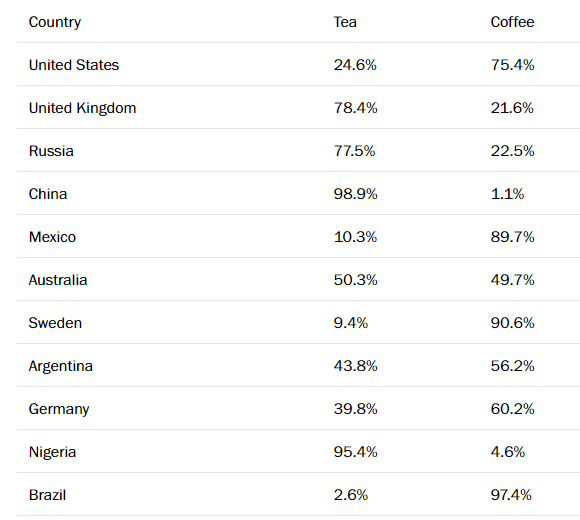
Forbes also reported:
“Tea consumption has grown 20 percent since the turn of the millennium and it’s becoming the beverage of choice for a whole generation of young Americans. When people under 30 were asked if they preferred coffee or tea, both proved equally popular, garnering 42 percent of the vote each. The most likely explanation for tea’s rise is its perceived health benefits, with green tea in particular proving a hit.”
Depending on where you go, each nation also has their own unique tea-drinking or coffee-drinking culture!
For example, in Italy, they have their own culture that influenced so much of the world! And in Argentina, they drink yerba mate and prepare it in a small gourd and drink it through a filtered metal straw called a Bombilla.
The next time you travel abroad, use it as an excuse to explore and try different beverages the way they do!
Tea vs. Coffee: Caffeine
Common wisdom says that coffee has more caffeine than tea.
The truth is that dry tea actually has more caffeine by weight than coffee. The difference is that more dried coffee is used than dry tea to make a single cup: thus, a cup of steeped tea contains significantly less caffeine than a cup of coffee of the same size.
Looking through the research and nutrition facts, tea has between 40–120mg of caffeine per 8 ounces while coffee has about 80–206mg. (Even at the highest caffeine levels, tea has only about half the caffeine you’ll find in a cup of coffee.)
Also, consider this: the caffeine in tea is directly related to how long you steep your tea. The longer a tea steeps, the higher the caffeine content. Thus, you can easily adjust the stimulating effects from your drink.
Finally, the energy that comes from tea is different from that from coffee. How? Because tea leaves contain an amino acid called L-theanine (not found in coffee) that works with your caffeine to generate a balanced stimulative effect in the body and mind.
Instead of that jolt of energy followed by a crash that happens with coffee or other caffeinated beverages, you tend to feel a gradual increase in energy that maintains a calmer, clearer, and focused mindstate.
Tea vs. Coffee: Health Benefits
What’s better for you: coffee or tea?
Okay… this is tough to answer because there’s a lot of research that suggests both offer incredible health benefits:
1. Coffee and tea can help you lose weight
The caffeine in the coffee and tea can help you burn more fat. Normal consumption of it can increase your metabolism and increase your body temperature. Dutch researchers found that a high-caffeine group lost more weight and body fat than a low-caffeine group in four weeks. Also, a study of over 7,000 people found a negative correlation between diabetes risk and drinking coffee or tea.
There’s also a powerful catechin in green tea called epigallocatechin gallate (EGCG) that may have fat loss effects independent of caffeine. Researchers found that “EGCG alone has the potential to increase fat oxidation in men and may thereby contribute to the anti-obesity effects of green tea.” Japanese researchers also found evidence of this catechin’s ability to fight obesity.
2. Coffee and tea can improve your mood, energy levels, and brain function.
Research from the UK found that a realistic amount of coffee consumption increases alertness and improves cognitive function. Coffee could also protect against dementia and Alzheimer’s.
Regarding tea, a study suggested that the EGCG in green tea (as well as its other flavonoids) could reduce a certain aspect of Alzheimer’s disease as well. Researchers from the Netherlands suggested that L-Theanine found in green tea can improve alpha activity in the brain, increasing mental alertness and attention.
3. Coffee and tea are associated with longer lifespans.
In an 18–24 year study on over 120,000 male and female participants, coffee was associated with a lower risk of mortality. Another analysis of almost 1,000,000 participants found a similar association between coffee and all-cause mortality.
In the British Journal of Nutrition, researchers analyzed 18 prospective studies and found that tea could reduce the risk of all-cause mortality. Another long-term study done in Japan found that green tea consumption can reduce the risk of death due to cardiovascular disease.
4. Coffee can reduce the risk for Type II Diabetes.
A long-term study of over 120,000 people by the Harvard School of Public Health found that drinking coffee was associated with a significantly lower risk of Type II diabetes. What’s more interesting was that both caffeinated and decaf coffees had an effect, which suggests there could be something within coffee itself that’s responsible for this health benefit.
5. Tea has the potential to fight and prevent cancer
Researchers from China suggested that green tea could possibly help with breast cancer prevention. Another study found similar benefits with breast cancer prevention from green tea.
A 2012 study in Nutrients suggested that the EGCG in green tea could have anticancer benefits. Research from LSU found that a treatment with EGCG could significantly reduce serum markers (like PSA, VGF and VEGF) that predict the progression of prostate cancer.
A prospective study out of Vanderbilt University also found that drinking tea was associated with a lower risk of digestive cancers (and the risk further decreased with higher tea consumption and a longer period of consumption).
You can find more info about the tea and anti-cancer potential from the National Cancer Institute.
6.Coffee can protect your liver.
Italian researchers found an inverse association between drinking coffee and the liver cirrhosis. Another study from Italy found a similar link between coffee (but not any other caffeinated beverage) to prevent the onset of this disease.
7. Tea and coffee can reduce the risk of cardiovascular disease
A 13-year study from the Netherlands found that tea and coffee was linked to a lower risk of cardiovascular mortality (and a stronger link with tea than with coffee).
Research from the Harvard School of Public Health found that the antioxidants in green tea can possibly help block the oxidation of LDL (bad) cholesterol while increasing HDL (good) cholesterol and improving artery function.
Yet with these health benefits, make sure that your drinks are healthy!
Coffee and tea are super-low calorie drinks and contain anywhere from 0 calories to maybe 2–3 calories if it’s a cup of black coffee. But often, we don’t drink coffee or tea “plain” — and by adding milk, cream, sugar, honey, syrups, etc. into your cup can completely change the health profile of your drink.
While coffee typically lends itself to more of those sugary, mocha, frappe, iced, etc. tea also has common additives like honey, sugar, cream, and tapioca pearls.
Just make sure you keep your beverage a la carte and you’ll be able to reap all these yummy health benefits and feel great!
In summary:
Both drinks have a wide range of health benefits. A good chunk of that is because both have caffeine, which can improve fat loss and cognitive function. Independent of that, tea offers natural chemicals that can protect against heart disease and, possibly, certain types of cancers; coffee can potentially reduce the risk of Type II diabetes. As for overall health improvements and research, it seems that tea has the edge, but coffee is pretty darn good, too. Just make sure, when you drink your beverage, don’t add a ton of sugar, milk, whipped cream, etc. to it and you’ll preserve those benefits.
Tea vs. Coffee: Popular Drinks
Here’s what we love about tea and coffee: not only do they taste terrific “a la carte,” but they also lend themselves to mouth-watering drink recipes enjoyed by MILLIONS around the world.
Favorite Coffee Drinks
Cappuccino and Latte
Ahh, there’s nothing like a tasty cappuccino to sip while eating a fresh pastry to hanging out with good friends.
The cappuccino contains:
1/3 Espresso
1/3 Steamed Milk
1/3 Milk Foam
Not only does it taste amazing, but it offers a unique mouthfeel that can range from velvety to dry. As for the latte, it comes from the Italian term, caffè latte(which means “milk coffee”), and contains roughly:
1/6 Espresso
4/6 Steamed Milk
1/6 Milk Foam
Also, because of the layer of milk foam, baristas can use lattes to create beautiful pieces of art swirled onto the top.
Cold Brew Coffee
The next time it’s hot outside, beat the heat with a glass of refreshing “cold brew” coffee.
Unlike a normal cup of coffee (or iced coffee), cold brew is steeped a room temperature or colder to create lower acidity for a smoother, sweeter taste. When you brew coffee with hot water, you unleash certain compounds and acids that only occur with high temperatures. Brewing with cold water, however, extracts the flavor notes from the beans without many of the bitter acids and compounds.
Instead, time replaces heat as cold brew has a longer extraction time that can take anywhere from 12–24 hours.
Favorite Tea Drinks
Masala Chai
Chai is India’s national drink! With a mix of black tea leaves and spices like cinnamon, ginger, nutmeg, cloves, cardamom, and pepper, this spicy and flavorful milk tea is such a staple of daily life that it’s sipped on the go, offered to guests, and sold almost everywhere in the country!
To learn how to create your own delicious and easy-to-make chai latte, check out our video:
Sweet Tea
Sweet tea is as famous in the South as “southern hospitality.” When you think of this drink, you can’t help but conjure images of lazy summer afternoons on a local patio. But it’s not just a great drink! In fact, sweet tea also has some really amazing health benefits.
To make your own healthier sweet tea, check out our fast and easy recipe!
Tea vs. Coffee: Which One Is Right For You?
It depends on you.
There aren’t many drawbacks to either one, but here are some things to consider:
- Tea. It might interfere with your absorption of iron if you are iron deficient. Also, if you want to burn the midnight oil, tea might not be strong enough to power you through compared to coffee. Finally, tea (and coffee too) is a natural diuretic and can make you take more trips to the bathroom than you’d like.
- Coffee. It can make you jittery and affect your sleep if consumed too late in the day. (Doctors recommend that pregnant women shouldn’t drink caffeinated coffee.) Coffee also tends to stain teeth with a lot of consumption and can contribute to gastrointestinal distress.
(These issues, however, are usually caused by an excess of either.)
The great thing about coffee is there are so many different ways to enjoy it. Hot, iced, cold-brew, pour over, or in an espresso drink!
The great thing about tea is that there are thousands of different varieties and blends.
At Art of Tea, we have over 200 handmade tea blends. We also carry the largest variety of certified organic teas, as well as many fair-trade certified teas.
If you’re not sure where to start your exploration into tea, check out our Tea Wizard.
Just answer a few quick and easy questions about your lifestyle and your tea drinking habits, and we’ll give you new, tasty recommendations!
Over 13,000 tea drinkers around the world have already used it to explore new tea blends based on their palettes and hobbies and the results have been awesome (and delicious).
Art of Tea is an award winning purveyor of specialty and organic teas, based in Los Angeles, CA.
If you found this article helpful, please share it with coworkers, colleagues, and fellow lovers of tea.

